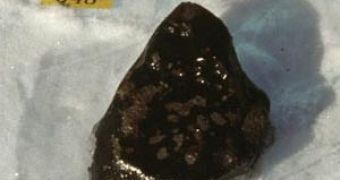Last December scientists discovered in Antarctica a type of lunar meteorite seen only once before.
The finding was made by a team from the U.S. Antarctic Search for Meteorites program (ANSMET) headquartered at Case Western Reserve University.
The meteorite was on an icefield in the Miller Range of the Transantarctic Mountains, roughly 750 km from the South Pole.
It weighs 142.2 g, and it is a black rock, slightly larger than a golf ball. The rock was named MIL 05035.
During the austral summer of 2005-2006, ANSMET collected 238 meteorites.
Harsh weather limited the number of meteorite findings.
Specialists said the rock has an unusual mineralogy and texture and the meteorite is a very old piece of the moon that could deliver information about moon's history.
The meteorite is a very coarse-grained gabbro, similar in composition to the basaltic lavas that fill the lunar maria, but its very large crystals suggest slow cooling deep within the Moon's crust.
The plagioclase feldspar has been completely transformed to glass (maskelynite) by extreme shock (presumably impact events).
This specimen closely resembles another Antarctic meteorite, Asuka 881757, one of the oldest known lunar basalt samples.
MIL 05035 gives scientists the opportunity to study a piece of the Moon apart of the samples provided by the US Apollo program.
Many researchers believe that Apollo visited some of the most unusual and geochemically anomalous regions of the Moon, and lunar meteorites give us more representative samples of the whole Moon.
MIL 05035 seems to have an old age and may provide new data on the early intense bombardment of the Earth-Moon system.
This field season was the fourth of a cooperative effort by the National Science Foundation (NSF) and the National Aeronautics and Space Administration (NASA) to enhance recovery of very desired Martian samples.

 14 DAY TRIAL //
14 DAY TRIAL //